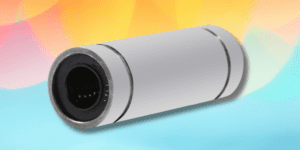Application of 3D printers
The first association that comes to mind is the production of plastic components, for example housings for electronic devices or plastic parts for cars. However, it is also possible to print with other materials – including plastic-wood and plastic-gypsum composites, resin, rubber, chocolate, sugar, paper, concrete, metal or sand, and even living tissue to a limited extent. As a result, 3D printers are used in many fields: they are used in the production of RTV and household appliances, prostheses, structural elements in modular buildings, toys and thousands of other items. They are also perfect for creating all kinds of mock-ups, models and prototypes.
Advantages of 3D printing Compared to traditional methods of making things, 3D printing is a much faster, more economical, more flexible, and ecological solution. The reason for this is, among other things, the lack of need to use tools, as well as the reduction of waste and material consumption (exactly as much material is used as is needed to make a given product). With this technology it is also possible to obtain elements with very complex shapes, which can be very complicated or even impossible with traditional methods. The advantage of elements obtained by the method of 3D printing is also a relatively low weight (due to the materials used and high precision), which is extremely important in the case of products such as vehicles, prostheses or miniaturized electronic devices.
Types of 3D printers Depending on the printing technology and the material used, 3D printers can be divided into several basic categories:
Using filament spools
FDM (Fused Deposition Modelling)/FFF (Fused Filament Fabrication)
It is the most popular technology on the market for home and semi-professional printers. The material is plastic, which is fed into the printer as a filament. It is then heated to a suitable temperature, and after a semi-liquid consistency is reached, the filament is applied layer by the print head. Bonding occurs under the influence of temperature, and after cooling, the object takes on an almost homogeneous structure. FDM printers can work with materials such as ABS or PLA.
Using light-curing resins
SLA (stereolithography)
In this technology, objects are printed using light-curing resin. In this case, the liquid resin is poured into a special container in which there is a work table. Curing takes place with the help of a laser beam – the table is lowered layer by layer and the beam copies the desired shape in the XY plane.
DLP (Digital Light Processing)
In this case, the resin is cured by the light of the projector, which is located under the container with the liquid working material. The entire layer is cured in an instant. However, shrinkage can be a problem in the case of larger objects.
MJP (Multi-Jet Printing, PolyJet)
This technology is based on a similar principle to printing on paper with a laser or ink – the head moving over the printing table sprays a layer that is simultaneously cured by ultraviolet radiation. Once the entire layer is applied, the worktable is lowered and the process is repeated.
Using powders
CJP (Colour Jet Printing)
This technology uses a plaster-based powder material. Its layer is placed on the surface of the work table, and then the print head sprays coloured ink and binder in appropriate places. After removal and cleaning of powder residues, the finished element is chemically hardened.
Binder Jetting
This technology is suitable for printing with powdered metals, ceramics or sand. It does not require supporting structures and the principle of creating objects is similar to traditional (inkjet) printing. This method is used in industry to create durable components such as moulds.
SLS (Selective Laser Sintering)
This method involves 3D printing with powdered plastic melted by a laser beam. The printed elements are ready after removal from the powder and cleaning.
SLM/DMLS (Selective Laser Melting/Direct Metal Laser Melting)
A technology that involves printing with powdered metals melted by a laser beam.
EBM (Electron Beam Melting)
In this process, 3D printed elements are made from powdered metals that are melted with an electron beam.
MJF (Multi-Jet Fusion)
A technology in which printing is done with powdered polyamide. It is glued together by a binder sprayed on by the print head and then welded at high temperature.
Bioprinting
Printing from living biological material. You can get tissue fragments and even organs in this way.
Printing from ductile materials
Used chiefly in art and confectionery. It is the printing from materials such as chocolate and ceramics.
LOM (Laminated Object Manufacturing)
The method of 3D printing with layers of paper with glue and polyester laminate, cut with a laser.
Home and professional printers Home printers differ from professional printers mainly in the accuracy and quality of the elements obtained, as well as the printing speed and the possible intensity of use. Of course, between the cheapest models for a few hundred zlotys and industrial devices worth several millions, there is also a large number of intermediate solutions – for example, higher quality home printers, as well as semi-professional devices for use, for example, in a small company to create mock-ups for clients. It is also worth remembering that most AM technologies are not available in devices for hobbyists – they usually only allow FDM or SLA printing.
How much does a 3D printer cost?
The cheapest printers, which allow the production of small elements, can be bought for as little as a few hundred zlotys. A good quality hobby or semi-professional printer will cost from a few to a dozen thousand zlotys – such devices are suitable, for example, for electronics who need a device for prototyping or for a small business that wants to create models of its products in 3D. More advanced industrial printers can cost up to several million zlotys, and their capabilities enable the precise creation of very complex elements with strictly defined functional properties (e.g. automotive parts or dentures).
Do you need a 3D printer? This is the most important question you should ask yourself before buying a printer. If you plan to print a lot of items or you are simply intrigued by AM technology as such, the answer is obviously “yes”. However, if it is a one-time situation, an easier solution would be to hire a company to print your design at an affordable price or create it according to your instructions.
Choosing a 3D printer There is no universal recipe for choosing a good 3D printer that will work in every case, as users’ needs and capabilities vary. Among the factors worth considering when selecting a printer are:
What do you want to print and for what purpose? Of particular importance are the size of the elements, the desired functional characteristics and subsequent application, as well as the expected precision and speed of printing.
Do you have space for the printer? Some technologies are hazardous to health and require a dedicated space.
How much can you spend on a printer? As a rule, a higher price goes hand in hand with better print quality and higher device performance.
FDM or SLA/DLP? FDM printers are the most common for home and semi-professional use. They use a filament (plastic) on spools that are inserted into the print head. SLA and DLP printers are also relatively popular; they use photosensitive resins. Each of the above types has its advantages and disadvantages, so it is worth familiarising yourself with them before making a purchase decision.
FDM
In this technology, semi-fluid plastic is extruded from the print head, layer by layer. This is the most popular type of 3D printer for hobby use. Depending on the number of print heads, it is possible to print in one or more colours. The working material is plastic – most commonly PLA or ABS. The disadvantage of this technology is that the accuracy of the created elements is lower than in the case of SLA, as well as the layers are clearly visible (that’s why transparent printing is impossible), and a large number of supports is needed for more complex projects.
The technology is based on curing the photosensitive resin layer by layer. The great advantage of this method is the accuracy and the possibility of creating very precise designs, as well as the wide range of materials. It is possible to print transparent and translucent objects and to combine several fragments using the same resin. The downside is the toxicity of the resin (before it has cured) – the material must be tightly sealed and protected from light, and the work area must be carefully ventilated. It is not possible to use more than one colour or material at a time, and after printing the element must be cleaned of the uncured resin. The printing material itself is also much more expensive than thermoplastics.
Planned use The choice of printing technology and then a particular printer model depends on what effect you want to achieve. Among the most important factors that determine the functional properties of the printed elements are
The printing material
For home and semi-professional use, printing materials can be broadly divided into two main groups: thermoplastics (ABS, PLA) and light-curing resins.
ABS (Acrylonitrile Butadiene Styrene)Thermoplastic material used in FDM printers. Requires a heated print bed and a print head that can reach a temperature of at least 240ºC. It is petroleum based, which means it gives off potentially harmful fumes during printing. It is harder and more heat resistant than PLA and is also suitable for further processing (e.g. sanding or drilling holes). However, it is also more contractile, which is detrimental to the accuracy of the project.
PLA (Polylactide)Thermoplastic material used in FDM printers. It is made from natural raw materials such as cornmeal. It is biodegradable and safe to use (you can print in rooms with people or animals). It is smoother and shinier than ABS, and the colour range is wider. However, it is more difficult to remove the supports, so they must always be placed in carefully planned locations.
Light-curing resins
Material used in SLA printers. Because of their high toxicity and unpleasant odour, light-curing resins must be stored in airtight packages and the printing process should take place in a well-ventilated room. The advantage of this material is the possibility of printing extremely precise elements, even transparent ones. However, due to the high price and difficulty of operation, SLA printers are rarely used at home.
Number of heads
When printing using FDM technology, it is possible to use more than one material or simultaneously. To do so, you need a printer with two print heads. This is a more expensive solution, but offers many possibilities: for example, you can print a model in two colours or create water-soluble supports. The disadvantage is the longer working time and – when using a water-soluble support filament – also the high price of the material.
The print volume
The current standard is a print volume of about 20 centimeters in each of the dimensions. There are also large format printers, but they are not as popular as the smaller models due to emerging problems with material shrinkage and temperature control.
Popular models The selection of 3D printers is huge, making it impossible to mention all the good solutions. Here are some of the most popular models for home or business use.
Printers for home use
Inexpensive models that are perfect for hobbyists who want to print at home.
Monkeyfab Spire
It is characterized by high print quality and detailed reproduction of details. It is suitable both as a home printer for demanding users and as a company printer or teaching tool. It prints elements with a maximum diameter of 15 cm and height of 17 cm.
Prusa i3 MK2
Czech open source printer. It can be purchased both in a version for self-assembly and already assembled.
UP Mini 2
An excellent choice for users who need to print small elements (up to 12x12x12cm). The printer has a WiFi module, a closed working chamber and a built-in HEPA filter.
Anet E10
A low-budget 3D printer. Its advantages are: an attractive price and a large working area, which allows you to print elements up to 30x27x22 cm.
Printers for business use These models will work well for printing projects and models in your company:
CraftBot XL
Printer with a print volume of 30x20x44 cm. It is great for printing using materials with low shrinkage, such as PLA.
HBot F300
Equipped with a closed working chamber and a control system. An attractive and popular device that is intuitive to use and has a reasonable price / quality ratio.
MakerBot Replicator Z18
A device for demanding customers. It has a large print volume of 30x30x45 cm, a closed and heated work chamber and professional, intuitive software. The only drawback is the inability to print from materials other than PLA.
Test print If you are still in doubt about which model to choose, it is best to order test prints from the printers you are considering buying. Many manufacturers offer such an option, often even free of charge. Thanks to a test printout, you can quickly verify whether a particular model meets your expectations.
choose our first device . Here, there is usually a challenge similar to the one we face when buying almost any device. It is a lack of knowledge about what to look for when choosing a model for yourself. In this post, we will try to help you understand this topic.
Which material? One of the absolutely fundamental questions we have to ask ourselves concerns the material, that is, the filament PLA filament 3D printer ABS filament PETG , HIPS Rubber are also popular materials.
Application Another point to consider when choosing a 3D printer is the intended application, which differs significantly between home and professional use. In the commercial case, any savings sooner or later will have a significant impact on us – be it reliability or the quality of the printed objects. However, if we buy our 3D printer with the idea of having fun with it, we can go for a more affordable one.
Recommended 3D printers for home use
Recommended 3D printers for business use
What else to look for when buying your own 3D printer ? It is good that the device we buy automatically supports the most common file formats with projects. In addition, due to the specificity of 3D printing technology LCD touch panel
As you can see, choosing a 3D printer is not as easy as it may seem, especially if we want to take into account as many factors as possible, including the highest possible quality combined with reliability and efficiency.




